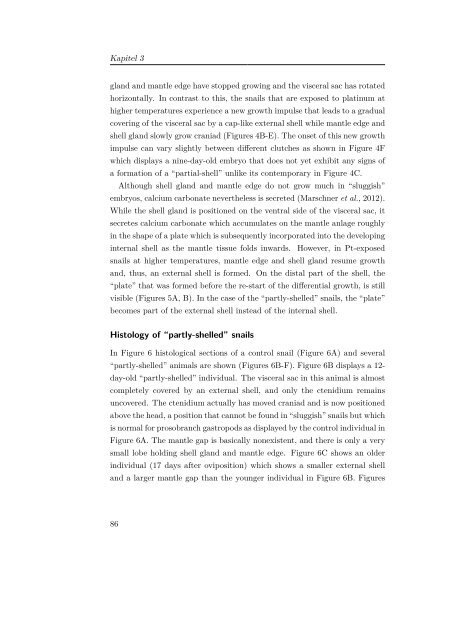Die Embryonalentwicklung der Paradiesschnecke ... - TOBIAS-lib
Die Embryonalentwicklung der Paradiesschnecke ... - TOBIAS-lib
Die Embryonalentwicklung der Paradiesschnecke ... - TOBIAS-lib
You also want an ePaper? Increase the reach of your titles
YUMPU automatically turns print PDFs into web optimized ePapers that Google loves.
Kapitel 3<br />
gland and mantle edge have stopped growing and the visceral sac has rotated<br />
horizontally. In contrast to this, the snails that are exposed to platinum at<br />
higher temperatures experience a new growth impulse that leads to a gradual<br />
covering of the visceral sac by a cap-like external shell while mantle edge and<br />
shell gland slowly grow craniad (Figures 4B-E). The onset of this new growth<br />
impulse can vary slightly between different clutches as shown in Figure 4F<br />
which displays a nine-day-old embryo that does not yet exhibit any signs of<br />
a formation of a “partial-shell” unlike its contemporary in Figure 4C.<br />
Although shell gland and mantle edge do not grow much in “sluggish”<br />
embryos, calcium carbonate nevertheless is secreted (Marschner et al., 2012).<br />
While the shell gland is positioned on the ventral side of the visceral sac, it<br />
secretes calcium carbonate which accumulates on the mantle anlage roughly<br />
in the shape of a plate which is subsequently incorporated into the developing<br />
internal shell as the mantle tissue folds inwards. However, in Pt-exposed<br />
snails at higher temperatures, mantle edge and shell gland resume growth<br />
and, thus, an external shell is formed. On the distal part of the shell, the<br />
“plate” that was formed before the re-start of the differential growth, is still<br />
visible (Figures 5A, B). In the case of the “partly-shelled” snails, the “plate”<br />
becomes part of the external shell instead of the internal shell.<br />
Histology of “partly-shelled” snails<br />
In Figure 6 histological sections of a control snail (Figure 6A) and several<br />
“partly-shelled” animals are shown (Figures 6B-F). Figure 6B displays a 12-<br />
day-old “partly-shelled” individual. The visceral sac in this animal is almost<br />
completely covered by an external shell, and only the ctenidium remains<br />
uncovered. The ctenidium actually has moved craniad and is now positioned<br />
above the head, a position that cannot be found in “sluggish” snails but which<br />
is normal for prosobranch gastropods as displayed by the control individual in<br />
Figure 6A. The mantle gap is basically nonexistent, and there is only a very<br />
small lobe holding shell gland and mantle edge. Figure 6C shows an ol<strong>der</strong><br />
individual (17 days after oviposition) which shows a smaller external shell<br />
and a larger mantle gap than the younger individual in Figure 6B. Figures<br />
86
















